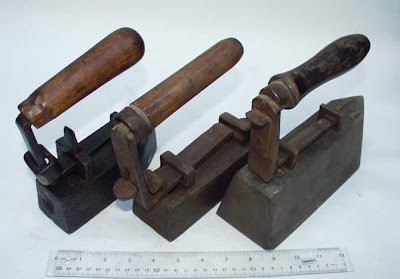The history of the iron
Now we are not confronted with problems that arose earlier. Took iron, thrust into the socket and rushed. then this was not, ironing process was far more troublesome. In this picture are some of them: plates, goose different forms for draperies and some places in the suit and hat.
The first device for ironing clothes, probably had a flat heavy stone. To cave paintings of ancient Aztecs captured as the process of ironing: clothes spreading out on a flat surface, press down on top of the stone and left for a while under that pressure. In the IV century BC Greeks invented a way of pleating clothing with metal rod like a rolling pin. Two centuries later, the Romans beat the wrinkles out of clothes hammer metal, heated to a high temperature.
In Russia, was common way Ironing with Rubel and round whitefish: Planed smooth on the stick wound dried sheets and rolled it on the table top with corrugated board. This principle is still used in some ironers.
Brazier Iron coals inside appeared only in the middle of the XVIII century. Before this tool ironed clothes very similar to a large skillet. The closest was the predecessor of the modern iron brazier of coals.
It looked almost exactly like a regular pan, inside the cast iron roasting pan with handle laying the hot coals and a kind of "pan" began to drive on the clothes. Clearly, this "iron" is no different convenience and safety: to work with it was embarrassing, sparks and small embers and then flew out of the fryer, leaving clothing opaline and holes.
Irons with a removable handle
over time began to use two irons: while one is heated on the stove, the other stroking. The simplest irons - heating. Before the use of cast iron monoliths warmed in the oven. Irons for the fabric weighed differently from one to 10 pounds. Another kind of old irons - cast iron, heated over an open fire or in a hot oven. They appeared in the XVIII century and still produced in our country even in the 60's. XX century, in spite of the fact that for a long time been invented electric iron. This is because many homes have not been provided for the outlet.
Iron iron warming up for a long time - at least 30 minutes, and it can not be hot to take without potholders. So soon these irons improved: they were doing párnymi - with one removable handle on two cast-iron base. While one rubbed, heated second base, so that the process of ironing markedly accelerated.
Charcoal brazier replaced with pen came a steam iron. Coals it housed inside the case and close the lid, and the top, for better traction, are attached tube. To better heated coals, making the holes on the sides. Waving this iron back and forth, intensified ventilation.
These irons are no different convenience and security: sparks and small embers and then flew out of the fryer, leaving clothing opaline and holes. For better traction on the sides to make the holes, sometimes even supplied with an iron pipe. To re-ignite the coals have cooled down, the holes were blowing or waving iron from side to side. As the irons were heavy ironing turns into a strength exercise for the muscles of the hands.
We have such irons are known from the XVII century, and in the West, probably even earlier. The first written evidence of irons in use is dated February 10, 1636. The book costs royal court noted: "The Smith Ivashka Trofimov issued five pennies, and it closed up for the money in the Tsarina's Chamber iron iron." In the XVIII century has been adjusted industrial production "ghost" Iron: Demidov made them and some other foundries.
Large iron irons weighed up to 10 kg and were intended for ironing coarse fabrics. For ironing delicate fabrics and fine details of clothing - cuffs, collars, lace - used small ironing, as small as a half-palm.
Iron-boxes, where to put a hot bar Instead of coal into a red-hot iron has invested iron disc:

At the beginning of XX century, the increasing popularity began to enjoy more secure than gas, alcohol-iron. His ads were to be found in magazines in 1913. It was constructed on the principle of an oil Lama: the surface of the iron is heated with alcohol, which is poured in and set on fire. The advantage of this iron was that he quickly warmed up, weighed not a lot, it can be used as a road version. Here are just a cost too much iron.
Irons professional dressmaker goose should be heavy, not less than one kilogram. Usually tailors had several irons of different sizes and weights. Were irons and up to 12 pounds.
Tailoring the case without iron hard to imagine. We tailor a saying: "The Tailor crap - iron irons." Maybe it does not sound very nice, but the bottom line reflects true. Without sutyuzhki, streamers and other operations that must be done after each seam (for which there is a special term razutyuzhit, zautyuzhit, priutyuzhit, vyutyuzhit) - a good thing very poor.
There is even a tailor, the term "kill", this is usually done on the edge of the board or on a thick place in the joint.
For hard to reach places in the arm, shoulder, armpits, etc.:
















































